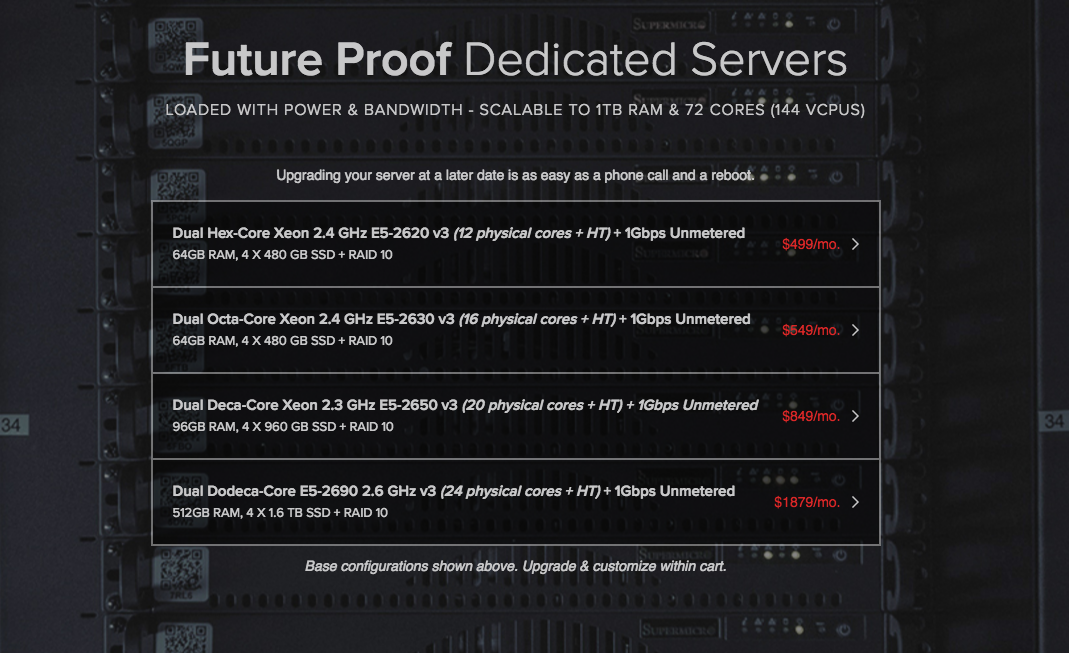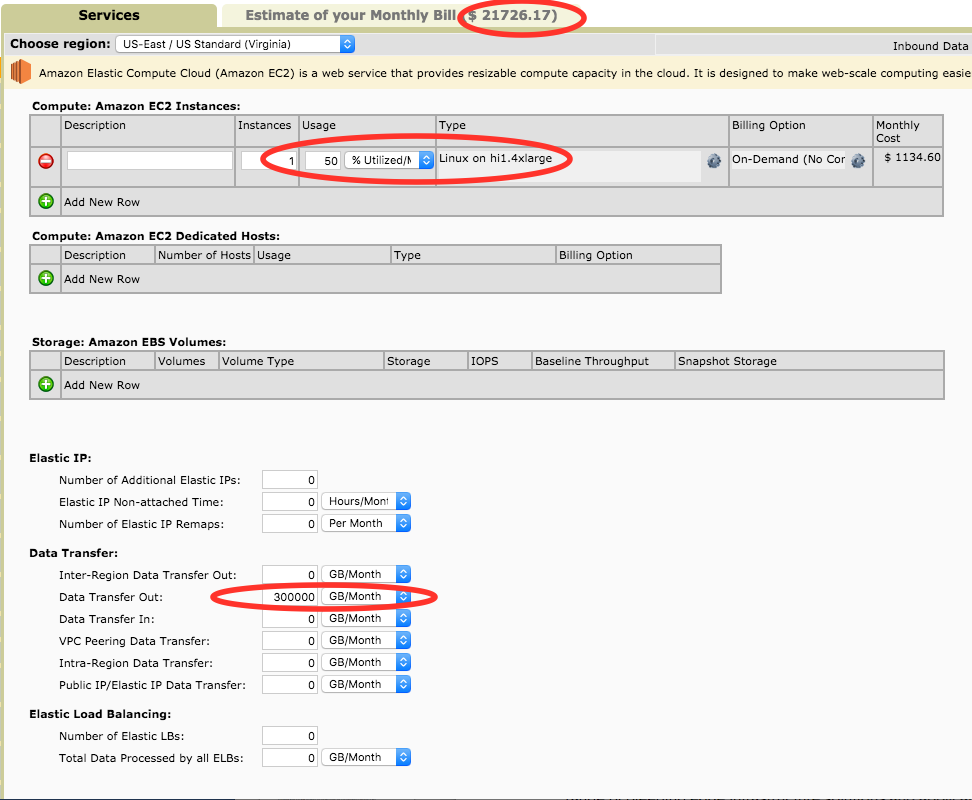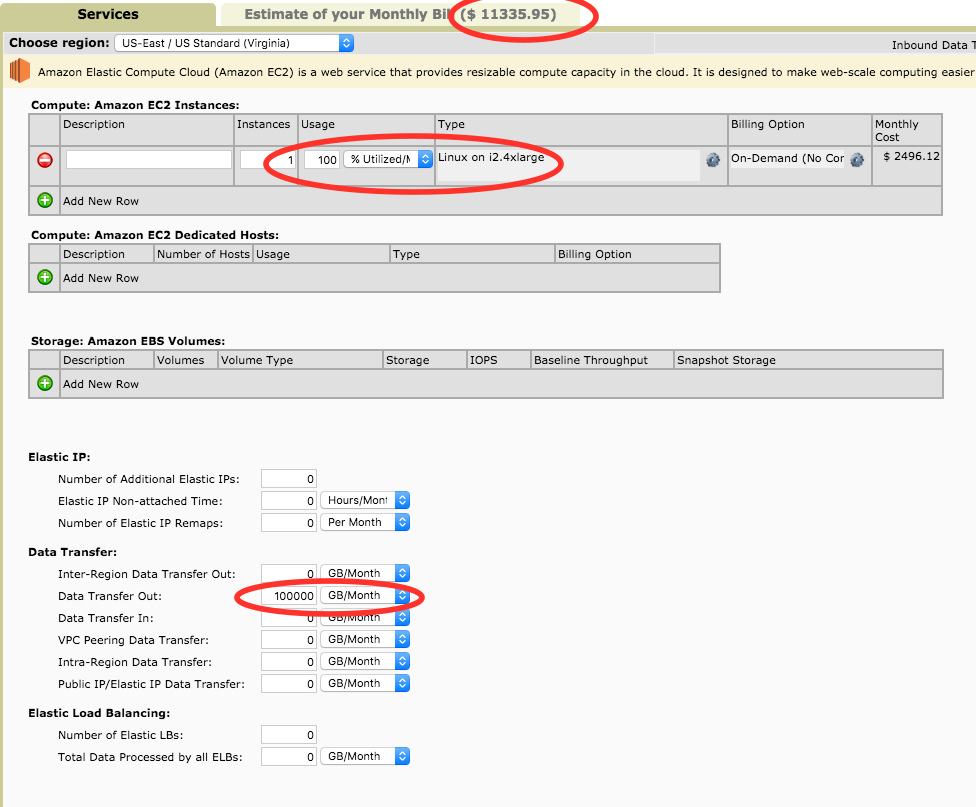First, let me explain what a “Future Proof Dedicated Server” is. The idea is to provide a bare-metal server that has so much power and bandwidth included day one, the need to scale in the future becomes moot. With that said, if down the road the need to add more resources does arise, it is as simple as a trouble ticket and a reboot. Each of our Future Proof servers is scalable to 1024 GB of DDR4 ECC REG memory, 72 physical cores (144 vCPUs), and 10Gbps unmetered throughput. Our Future Proof Dedicated Servers deliver a solid system infrastructure with redundancy and scalability while providing a predictable and controllable cost structure.
With the introduction of this new line of beefy servers, we thought it would be interesting to see how they compare in both price and scalability to similar specs in Amazon Web Services. We conducted a similar comparison to AWS last year using a current customer’s usage. Those results proved dramatic.

With our Future Proof server line, we created 4 base configurations. We listed 4 base configurations in order to present a range of the available options, but in reality, the hardware specs of these servers can be customized a thousand different ways. The available configurations at AWS don’t exactly match with our base configurations so for the purpose of this comparison I used plans that were closest to a match as possible. Additionally, knowing 1Gbps unmetered (330,000 GB per month) is a lot of bandwidth, I compared our pricing to AWS options with minimal bandwidth as well as comparable bandwidth. In another effort to be fair to AWS, we have chosen several different compute usage ranges, from 25% to 100%. With our Future Proof Dedicated Servers 100% of the resources are available 24/7 of course. So, let’s see how things stacked up.
Future Proof Server- Baseline configuration #1
- Dual Hex-Core Xeon 2.4GHz E5-2620 v3 (12 physical cores with HT = 24 vCPU)
- 64 GB DDR4 ECC REG RAM
- 4 x 480GB Micro DC510 SSD
- RAID 10 (not mandatory but a hardware based RAID is free if wanted)
- 1 Gbps Port Unmetered Bandwidth
- Our price- $499/month, $0/setup fee
AWS – the closest to match available is the hi1.4xlarge instance
- 16 vCPUs
- 60.5 GB RAM
- 2 x 1024 GB SSD
- 5000 GB outbound bandwidth (chose standard “data transfer out” option”)
- 500 GB inbound bandwidth
- 25% utilization- $1117.55/month
- 50% utilization- $1741.58/month
- 100% utilization- $2989.64/month
AWS- hi1.4xlarge instance with comparable bandwidth throughput to the 1Gbps unmetered included with our Future Proof Servers.
- 16 vCPUs
- 60.5 GB RAM
- 2 x 1024 GB SSD
- 300,000 GB outbound bandwidth (chose standard “data transfer out” option”)
- 25% utilization- $21,119.16/month
- 50% utilization- $21,726.17/month
- 100% utilization- $22,940.19/month

As you can see from the above comparisons the Future Proof servers cost less even when compared to a 25% utilization plan at AWS. There was a difference in the SSDs included in these plans, however, with the AWS plan including 2 x 1024 (total of 2048 GB) and the Future Proof server plan including 4 x 480GB SSD (total of 1920 GB) producing a delta of 128 GB in AWS favor. However, our plan includes 8 more vCPU and a 3.5 GB more RAM which brings the overall package resources somewhat back to even. When we look at the AWS plan with minimal bandwidth usage (5,000 GB) many companies may consider the $600/month price difference nominal. However, once we start comparing the plans with equivalent bandwidth the cost spread quickly expands. Take notice that we included 300,000 GB of outbound transfer with AWS when in reality a 1Gbps unmetered port maxed out over 1 month will push about 330,000 GB outbound. We went with the lower 300,000 amount at AWS with the understanding that even the biggest bandwidth users have slow hours. We are doing our best to keep this comparison fair and square.
So let’s take a look at another 2 plans and see how they compare. With this new comparison I wanted to get as close to identical plans as possible so I started with AWS’s offerings and backed into one of our plans to make a match. With this premise in mind, I ended on the i2.8xlarge plan at AWS which includes 16 vCPUS, 122 GB RAM, and 4 x 800 GB SSD. I used the same 25%, 50%, and 100% utilization options but this time around, I opted for 5,000 GB and 100,000 GB of bandwidth to make sure we viewed a wider range of use cases.
Future Proof Server- Baseline configuration #1 with SSD upgrades available within cart
- Dual Hex-Core Xeon 2.4GHz E5-2620 v3 (12 physical cores with HT = 24 vCPU)
- 128 GB DDR4 ECC REG RAM
- 4 x 960 GB Micro DC510 SSD
- RAID 10 (not mandatory but a hardware based RAID is free if wanted)
- 1 Gbps Port Unmetered Bandwidth
- Our price- $654/month, $0/setup fee
AWS – the closest to match we could find is the i2.4xlarge instance
- 16 vCPUs
- 122 GB RAM
- 4 x 800 GB SSD
- 5,000 GB outbound bandwidth (chose standard “data transfer out” option”)
- 500 GB inbound bandwidth
- 25% utilization- $1179.95/month
- 50% utilization- $1866.39/month
- 100% utilization- $3239.25/month
AWS- i2.4xlarge instance with comparable bandwidth throughput to what is included with our Future Proof Servers.
- 16 vCPUs
- 122 GB RAM
- 4 x 800 GB SSD
- 100,000 GB outbound bandwidth (chose standard “data transfer out” option”)
- 25% utilization- $9,286.07/month
- 50% utilization- $9,972.51/month
- 100% utilization- $11,335.95/month

With our second comparison, the results are much the same. AWS is only $525/month more if you were to utilize only 25% of the compute each month and limited your outbound bandwidth to just 5,000 GB. Once you go to 50% compute utilization at AWS their premium increases and it is clear adding bandwidth dramatically increases costs exponentially. Take notice that the Future Proof Dedicated Server plan we used includes 8 more vCPU, 6 GB additional RAM, and 4 x 960GB SSDs (AWS includes 4 x 800GB).
If you are comparing Future Proof Dedicated Servers to AWS strictly on price, it is obvious dedicated servers clearly win. While plenty of companies choose AWS because they believe it will save them money, which we have proven above is often not the case, many companies find AWS desirable due to its ease of scale. AWS does indeed offer the ability to auto-scale, providing your application or online presence with more resources when needed. What is happening during this process, is AWS is spawning additional load-balanced instances to handle the surge. If, however, you wish to add resources to your existing instance, ex. more RAM or vCPUs, you log in to the AWS portal, pick your new plan, and perform a reboot. The reboot process takes about 10 seconds, so you face about 10 seconds of downtime.
Now let’s shift to scaling while on a dedicated server. First off, with our “Future Proof” servers, it is important to remember these are dedicated resources which typically outperform shared cloud environments pound for pound out of the gate. The point here is you will achieve better performance out of like CPU and RAM resources on dedicated, meaning the point at which you actually need to scale in the cloud may come earlier than it would on a dedicated server. With that said, the process of scaling a Future Proof server is similar to that of a cloud. Scaling out with additional servers involves adding more servers and a load balancer. We require 4 hours to deploy additional Future Proof servers (10-minute deployment for our prebuilt Instant Servers) and 30 minutes to set up the load balancer. To scale up, you log in to your portal, tell us how much more RAM and/or CPU you want, we take down the server at a time of your convenience, add the new hardware, and boot the server back up. This process takes anywhere from 5 minutes to 20 minutes depending on how much additional hardware you are requesting. So there is obviously a slight trade-off when it comes to scaling. Scaling up is a 10-second process in the cloud versus 5-20 minute process on dedicated. Scaling out can be instant in the cloud and requires several hours (no downtime) on dedicated. Keep in mind, with both solutions if downtime is required it can be accomplished at any time of day or night the customer chooses.
It is clear that both dedicated servers and the cloud have their advantages. Each company has to choose for themselves which is best for them. For many, a budget is one of the most important factors and saving $500-$20,000 per month is an easy trade-off for a 5-30 minute scaling process. For others, paying an extra $500-$20,000 is well worth it to know they can add near infinite resources in seconds. For most SMBs the need for infinite resources is just not their reality. For most SMBs a Future Proof Dedicated Server provides ample resources for today and years to come. Our hope is, regardless of what needs you have and what motivates your company, this comparison helps you pick the right solution for you.
Keep an eye out for our Future Proof Servers vs AWS hardware performance comparison coming in the next few weeks. We will be putting each of the same plans discussed today through benchmark testing to how the guts of each solution stack up against one another.
Additional Links:
Looking for more information on Hivelocity? Search our blog or look over our about page!
In need of more great content? Interested in cPanel, Private Cloud, or Edge Computing? Check out our recent posts for more news, guides, and industry insights!


